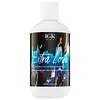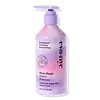What's inside
What's inside
 Key Ingredients
Key Ingredients

No key ingredients
 Benefits
Benefits

 Concerns
Concerns

 Ingredients Side-by-side
Ingredients Side-by-side

Water
Skin ConditioningCetearyl Alcohol
EmollientBehentrimonium Chloride
PreservativeCetyl Alcohol
EmollientPropanediol
SolventAmodimethicone
Cetyl Esters
EmollientGlyceryl Stearate
EmollientIsododecane
EmollientStearamidopropyl Dimethylamine
EmulsifyingButyrospermum Parkii Butter
Skin ConditioningSarcosine
Skin ConditioningSalvia Hispanica Seed Extract
EmollientSea Water
HumectantHelianthus Annuus Extract
EmollientTerminalia Ferdinandiana Fruit Extract
AntioxidantOryza Sativa Bran Extract
Skin ConditioningJojoba Esters
EmollientPanthenol
Skin ConditioningPhenoxyethanol
PreservativeCaprylyl Glycol
EmollientStearamine Oxide
CleansingIsopropyl Alcohol
SolventHydroxyethylcellulose
Emulsion StabilisingPolysorbate 60
EmulsifyingGuar Hydroxypropyltrimonium Chloride
Skin ConditioningChlorphenesin
AntimicrobialGlycerin
HumectantPolysorbate 20
EmulsifyingC11-15 Pareth-7
EmulsifyingLaureth-9
EmulsifyingDisodium EDTA
Cetrimonium Chloride
AntimicrobialTrideceth-15
EmulsifyingTrideceth-3
EmulsifyingEthylhexylglycerin
Skin ConditioningBenzyl Alcohol
PerfumingBHT
AntioxidantPentaerythrityl Tetra-Di-T-Butyl Hydroxyhydrocinnamate
AntioxidantTrideceth-12
EmulsifyingQuaternium-95
UV AbsorberCitric Acid
BufferingAcetic Acid
BufferingAlcohol
AntimicrobialCinnamidopropyltrimonium Chloride
Tocopherol
AntioxidantRosmarinus Officinalis Leaf Extract
AntimicrobialButylene Glycol
HumectantCystine Bis-Pg-Propyl Silanetriol
Skin ConditioningHydrolyzed Vegetable Protein Pg-Propyl Silanetriol
Skin ConditioningDisodium Phosphate
BufferingSodium Phosphate
BufferingPotassium Sorbate
PreservativeSodium Hydroxide
BufferingParfum
MaskingWater, Cetearyl Alcohol, Behentrimonium Chloride, Cetyl Alcohol, Propanediol, Amodimethicone, Cetyl Esters, Glyceryl Stearate, Isododecane, Stearamidopropyl Dimethylamine, Butyrospermum Parkii Butter, Sarcosine, Salvia Hispanica Seed Extract, Sea Water, Helianthus Annuus Extract, Terminalia Ferdinandiana Fruit Extract, Oryza Sativa Bran Extract, Jojoba Esters, Panthenol, Phenoxyethanol, Caprylyl Glycol, Stearamine Oxide, Isopropyl Alcohol, Hydroxyethylcellulose, Polysorbate 60, Guar Hydroxypropyltrimonium Chloride, Chlorphenesin, Glycerin, Polysorbate 20, C11-15 Pareth-7, Laureth-9, Disodium EDTA, Cetrimonium Chloride, Trideceth-15, Trideceth-3, Ethylhexylglycerin, Benzyl Alcohol, BHT, Pentaerythrityl Tetra-Di-T-Butyl Hydroxyhydrocinnamate, Trideceth-12, Quaternium-95, Citric Acid, Acetic Acid, Alcohol, Cinnamidopropyltrimonium Chloride, Tocopherol, Rosmarinus Officinalis Leaf Extract, Butylene Glycol, Cystine Bis-Pg-Propyl Silanetriol, Hydrolyzed Vegetable Protein Pg-Propyl Silanetriol, Disodium Phosphate, Sodium Phosphate, Potassium Sorbate, Sodium Hydroxide, Parfum
Water
Skin ConditioningSodium Cocoyl Isethionate
CleansingCocamidopropyl Betaine
CleansingGlycerin
HumectantCocamidopropyl Hydroxysultaine
CleansingGlycol Distearate
EmollientAcrylates Copolymer
Cocamide Mipa
EmulsifyingArgania Spinosa Kernel Oil
EmollientHydrolyzed Adansonia Digitata Seed Extract
Hydrolyzed Vegetable Protein
Skin ConditioningPolyquaternium-10
Polyquaternium-7
Polyester-11
Skin ConditioningGuar Hydroxypropyltrimonium Chloride
Skin ConditioningTetrasodium Glutamate Diacetate
Aminomethyl Propanol
BufferingPotassium Sorbate
PreservativeSodium Benzoate
MaskingCitric Acid
BufferingPhenoxyethanol
PreservativeParfum
MaskingWater, Sodium Cocoyl Isethionate, Cocamidopropyl Betaine, Glycerin, Cocamidopropyl Hydroxysultaine, Glycol Distearate, Acrylates Copolymer, Cocamide Mipa, Argania Spinosa Kernel Oil, Hydrolyzed Adansonia Digitata Seed Extract, Hydrolyzed Vegetable Protein, Polyquaternium-10, Polyquaternium-7, Polyester-11, Guar Hydroxypropyltrimonium Chloride, Tetrasodium Glutamate Diacetate, Aminomethyl Propanol, Potassium Sorbate, Sodium Benzoate, Citric Acid, Phenoxyethanol, Parfum
Ingredients Explained
These ingredients are found in both products.
Ingredients higher up in an ingredient list are typically present in a larger amount.
Citric Acid is an alpha hydroxy acid (AHA) naturally found in citrus fruits like oranges, lemons, and limes.
Like other AHAs, citric acid can exfoliate skin by breaking down the bonds that hold dead skin cells together. This helps reveal smoother and brighter skin underneath.
However, this exfoliating effect only happens at high concentrations (20%) which can be hard to find in cosmetic products.
Due to this, citric acid is usually included in small amounts as a pH adjuster. This helps keep products slightly more acidic and compatible with skin's natural pH.
In skincare formulas, citric acid can:
While it can provide some skin benefits, research shows lactic acid and glycolic acid are generally more effective and less irritating exfoliants.
Most citric acid used in skincare today is made by fermenting sugars (usually from molasses). This synthetic version is identical to the natural citrus form but easier to stabilize and use in formulations.
Read more about some other popular AHA's here:
Learn more about Citric AcidGlycerin is already naturally found in your skin. It helps moisturize and protect your skin.
A study from 2016 found glycerin to be more effective as a humectant than AHAs and hyaluronic acid.
As a humectant, it helps the skin stay hydrated by pulling moisture to your skin. The low molecular weight of glycerin allows it to pull moisture into the deeper layers of your skin.
Hydrated skin improves your skin barrier; Your skin barrier helps protect against irritants and bacteria.
Glycerin has also been found to have antimicrobial and antiviral properties. Due to these properties, glycerin is often used in wound and burn treatments.
In cosmetics, glycerin is usually derived from plants such as soybean or palm. However, it can also be sourced from animals, such as tallow or animal fat.
This ingredient is organic, colorless, odorless, and non-toxic.
Glycerin is the name for this ingredient in American English. British English uses Glycerol/Glycerine.
Learn more about GlycerinThis ingredient is derived from guar gum.
It is a conditioning ingredient, meaning it helps soften skin and hair.
Parfum is a catch-all term for an ingredient or more that is used to give a scent to products.
Also called "fragrance", this ingredient can be a blend of hundreds of chemicals or plant oils. This means every product with "fragrance" or "parfum" in the ingredients list is a different mixture.
For instance, Habanolide is a proprietary trade name for a specific aroma chemical. When used as a fragrance ingredient in cosmetics, most aroma chemicals fall under the broad labeling category of “FRAGRANCE” or “PARFUM” according to EU and US regulations.
The term 'parfum' or 'fragrance' is not regulated in many countries. In many cases, it is up to the brand to define this term.
For instance, many brands choose to label themselves as "fragrance-free" because they are not using synthetic fragrances. However, their products may still contain ingredients such as essential oils that are considered a fragrance by INCI standards.
One example is Calendula flower extract. Calendula is an essential oil that still imparts a scent or 'fragrance'.
Depending on the blend, the ingredients in the mixture can cause allergies and sensitivities on the skin. Some ingredients that are known EU allergens include linalool and citronellol.
Parfum can also be used to mask or cover an unpleasant scent.
The bottom line is: not all fragrances/parfum/ingredients are created equally. If you are worried about fragrances, we recommend taking a closer look at an ingredient. And of course, we always recommend speaking with a professional.
Learn more about ParfumPhenoxyethanol is a preservative that has germicide, antimicrobial, and aromatic properties. Studies show that phenoxyethanol can prevent microbial growth. By itself, it has a scent that is similar to that of a rose.
It's often used in formulations along with Caprylyl Glycol to preserve the shelf life of products.
Potassium Sorbate is a preservative used to prevent yeast and mold in products. It is commonly found in both cosmetic and food products.
This ingredient comes from potassium salt derived from sorbic acid. Sorbic acid is a natural antibiotic and effective against fungus.
Both potassium sorbate and sorbic acid can be found in baked goods, cheeses, dried meats, dried fruit, ice cream, pickles, wine, yogurt, and more.
You'll often find this ingredient used with other preservatives.
Learn more about Potassium SorbateWater. It's the most common cosmetic ingredient of all. You'll usually see it at the top of ingredient lists, meaning that it makes up the largest part of the product.
So why is it so popular? Water most often acts as a solvent - this means that it helps dissolve other ingredients into the formulation.
You'll also recognize water as that liquid we all need to stay alive. If you see this, drink a glass of water. Stay hydrated!
Learn more about Water